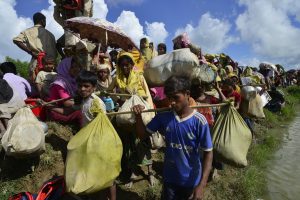Rows and rows of neatly set blocks of two-roomed tenements line the eastern corner of Bhasan Char, a 40-square kilometer sand-bar island off the coast of Bangladesh on the Bay of Bengal within Bangladesh’s territorial waters.
Women cradle their babies in the narrow and cramped balconies of this sprawling mass of concrete while the men idly wander about this bleak island colony. Bhasan Char is now home to about 20,000 Rohingya refugees, relocated a few years ago when the settlements in Bangladesh’s Cox’s Bazar began to get over-populated.
This is just a fraction of the total number of Rohingya refugees – about a million now in Bangladesh – who were settled in temporary shelters in Cox’s Bazar in the wake of the 2017 violent ethnic conflict in Myanmar’s Rakhine state. Around the same time, about 40,000 Rohingya fled to India – via Bangladesh – while several thousands were settled in Indonesia and Malaysia as part of an international effort to address the emergent refugee-humanitarian crisis.
The Bangladesh government’s effort to resettle the Rohingya refugees in Bhasan Char, which has an eerie and ominous ring about it – bhasan in English translates to “drifting” – has met with little success. Several Rohingya dared the sea, often with fatal consequences, to return to Cox’s Bazar, bringing into sharp focus the limits and extent of humanitarianism, especially when these efforts have mostly been “top-down.”
Even as the Bangladesh government aims to relocate 100,000 refugees to Bhasan Char, the Rohingya’s insecurities spring primarily due to extreme weather conditions and restrictions imposed on their right to mobility. The Rohingya have refused to be resettled to such a distant location that was, until recently, submerged under water. This has contributed further to their uncertain and precarious future in Bangladesh.
Today, as the military situation in Myanmar’s Rakhine State, home to the Rohingya, has turned in favor of the rebel Arakan Army, the spotlight has squarely shifted back on the refugees and their condition in Bangladesh, India, Indonesia, and Malaysia. After all, the conflict in Arakan State seven years ago forced the Rohingya to cross the borders into Bangladesh and further afield.
The Rohingya have often been termed as “stateless” – with none of the “receiving” states truly willing to admit them as a “people in crisis” and therefore deserving of “protection” – primarily because of their troubled past in Myanmar.
In the post-1941 period, after the Japanese invasion of British Burma, the Rohingya were integrated into the host Bengali community, owing primarily to their religious, cultural, and linguistic similarities. The Rohingya’s shared sense of belonging in the host state did not correspond with the territorial borders of post-colonial states. Rather, this was shaped by common cultural kinship, and religion or language.
Two concepts, statelessness and rightlessness, are key to understanding the Rohingya’s plight and the corresponding state responses or the lack of these.
In popular parlance, the statelessness construct is antithetical to citizenship; it is an “othering” of a citizen who also stands rightless. The Rohingya refugees experience everyday statelessness and rightlessness in the camps where the impact of such denial is negotiated almost daily.
Over the years, as the Rohingya’s condition in the camps did not improve significantly, the states increasingly prioritized national security over principles of refuge and hospitality which is essentially a performative act of “political responsibility.”
Scholars argue that the “harm” done to refugees and stateless people is both “legal and political,” entailing the denial of citizenship and “fundamental human qualities.”
From the perspective of refugees, humanitarianism is rooted in morality, justice, and mutual aid. At the same time, sanctuary revolves around the idea of belonging based on the territorial notion of citizenship. In the absence of a protection regime, refuge is provided on the basis of deep-rooted customs and practices.
While the practice of providing sanctuary is embedded in the cultural norms of individual nations, “their adaptations involve an inherent variation due to the differences in the modalities of laws, rules and regulations that are applied on an everyday basis.”
When humanitarianism in India, from the state’s perspective, has largely been “identity-based protection,” the Rohingya refugees in India, sprinkled across Jammu, Haryana, Delhi, and Hyderabad have constantly been described – explicitly and implicitly – as outsiders and therefore the “other.”
The Indian government’s anxieties with certain kinds of migrants, forced or otherwise, consistently viewed the “Rohingya’s illegal migration” through the security lens.
“…Their stay in India, apart from being absolutely illegal, is fraught with security ramifications,” the government said in an affidavit, and based this on “credible input about a large number of Rohingya indulging in activities of obtaining fake/fabricated Indian identity documents, human trafficking, subversive activities in different parts of the country, which poses threat to internal and national security.”
The Rohingya’s situation is very precarious both because of their ethnic origin and India being the second country of asylum. However, the precarious nature is also evident in the 34 camps in Bangladesh’s Cox’s Bazar district.
The refugee communities residing in these camps are stateless and yet “nationals of Myanmar.” The refugee communities rely on humanitarian assistance of aid agencies for protection, food, water, shelter and health, and reside in temporary shelters in highly congested camp settings.
Caught between the devil and the deep sea, the Rohingya consider the camps as home in the countries of asylum. Their collective condition is pitiable as they lead a life of indignity in exile with little or no hope of returning to Myanmar, their country of origin.
This article is part of a Special Report on the Rohingya refugees produced in collaboration with the Calcutta Research Group and the Asian Broadcasting Union.
Originally published under Creative Commons by 360info™.

































